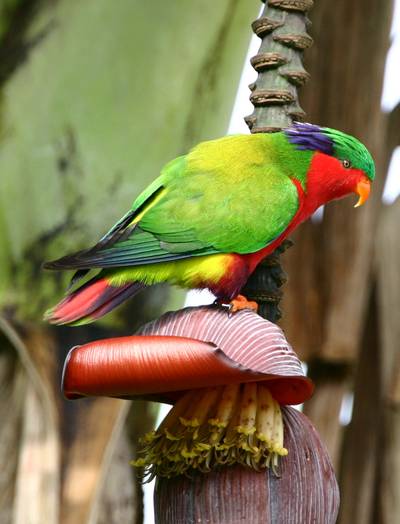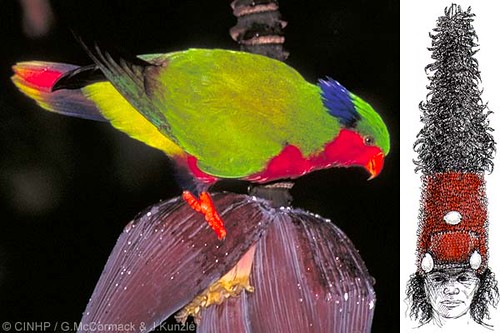tags: parrot, lories, lorikeet, loriinae, loriidae, Rimatara lorikeet, Kuhl's lory, Vini kuhlii, conservation, ornithology, South Pacific Islands
Back from the brink:
The endangered Rimatara lorikeet or Kuhl's lory, Vini kuhlii,
has been successfully reintroduced to Ätiu.
Image: Phil Bender.
As I've mentioned a few times already, my life's passion is the birds of the South Pacific, particularly the Loriinae, which are parrots commonly known as the lories and lorikeets. I study them professionally and I have lived with them and bred them for most of my life. So it was exciting to me when I learned that one of my favorite lory species, the endangered Rimatara lorikeet or Kuhl's lory, Vini kuhlii, experienced a conservation triumph several months ago: twenty-seven of the parrots were translocated from the island of Rimatara, in the Cook islands where a small population still exists, to the island of Atiu in French Polynesia, where they had been driven to extinction by the Maori hunters several hundred years ago. Officials hope that this homecoming will lead to establishment of a reserve population of the endangered birds.
Even though this translocation only occurred a few months ago, what is happening with these birds?
I am pleased tell you that the 27 captured lories released on Atiu several months ago have spread over the entire 30 square kilometers (12 square miles) of that island. The small island, located 187 kilometers (117 miles) northeast of Rarotonga, is a coral atoll that is also known as Enuamanu, or the land of the birds. The birds appear to be doing well.
Funds for this translocation effort were donated by the British Birdwatching Fair 2006 and by the American Lory Society and the American Society of Aviculture. Other forms of assistance were provided by the Ornithological Society of Polynesia (MANU, the BirdLife Partner Designate in French Polynesia), Te Ipukarea Society (TIS, the BirdLife Affiliate in the Cook Islands), and the Zoological Society of San Diego (ZSSD).
Even though many people and agencies were involved, "the reintroduction would not have been possible without the vision and generosity of the people of Rimatara, for whom the lorikeet is a symbol of joy and wellbeing," observed Gerald McCormak of the Cook Island Natural Heritage Trust, who led the collaborative effort.
Lories are small to medium-sized parrots that are typically brightly colored. They have a specially modified tongue that allows them to feed on nectar, pollen, fruits and insects. There are almost 60 species of lories and they are found throughout the islands of the South Pacific Ocean. However, some species live on very small islands, which limits their overall population size, making them vulnerable to extinction. The Rimatara lory, which lives on a tiny island (figure 1, below), is one such vulnerable species.
Figure 1: Ätiu is almost four times larger than Rimatara: 29 kilometers² versus 9 kilometers² so Atiu can, in theory, provide an adequate home for a much larger population of the Rimatara lory.
Image: NASA [larger image]
In 2000, the World Wide Fund for Nature sent an expedition to Rimatara to reassess the status of the Rimatara lory and also that of the introduced ship rat, which preys on the birds, as a follow-up to a survey that occurred in 1992. The team estimated the lorikeet population comprised only 750 birds, a decrease from 900 birds estimated in 1992, even though, luckily, the ship rat was not found.
Concerned that the birds were slipping into extinction, the Natural Heritage staff made two recommendations, first; increase quarantine procedures and awareness on Rimatara to prevent the accidental introduction of the ship rat, and second; establish a reserve population of the parrot on a ship rat-free island within its former natural range, namely within the Southern Cooks (figure 2, below). Several candidate islands were identified, but Ätiu was the only rat-free island deemed suitable for a reintroduction program since it had the same vegetation as Rimatara, ensuring that the birds would find the nectar and fruit that they depend upon.
Figure 2: The former and current natural ranges of the Rimatara lory.
Image: Cook Islands Natural Heritage Trust (CINHT) [larger]
To establish this reserve population on Ätiu, the people of Rimatara, along with the government of French Polynesia, collaborated with the Cook Islands Natural Heritage Trust to fly the 27 birds, known as 'Ura on Rimatara, to Atiu, where they are known as Kura. Staff from the Conservation and Research for Endangered Species (CRES) program at the at the San Diego Zoo helped collect the birds using mist nets, they cared for the birds while in quarantine, and evaluated their condition to ensure that only healthy birds were taken to Atiu.
"The effort was a complete success. All the birds ate well, maintained weight within reasonable limits, and flew well upon release," writes Alan Lieberman on his blog. Lieberman is the conservation program manager for CRES.
Thanks to a decree by the queen on Rimatara, these lorikeets are alive today because they were protected from being caught and removed from that island.
"On previous occasions the removal of birds from their island resulted in the birds' deaths, a phenomenon they attributed to the tapu [taboo] of their late Queen," said McCormack.
The Rimatara lory is no stranger to Ätiu. Both fossil records and oral tradition reveal that the Rimatara lorikeet was formerly found throughout most of the Southern Cook Islands where the diminutive parrot was much prized for its small red feathers, which were used for chiefly adornment, and for decorating ceremonial headdresses (figure 3). Unfortunately, because the Maori royalty on Ätiu so coveted this species' spectacular scarlet and emerald plumage for adornment, it was hunted to extinction.
"This was the bird that provided the feathers for chiefs and ceremonial costumes and most red-feathered birds in the Pacific have been wiped out," said McCormak.
According to local oral tradition, the last feather harvest in the Cook Islands occurred around the time Captain Cook visited in the 1770s. But the lorikeet was never recorded in the Cook Islands by any European visitors, so it probably went extinct on those other islands before the 1820s.
Figure 3: The Rimatara lory and one of the Maori chief's adornments
that its tiny red feathers were used to decorate.
Image: G McCormack and J Kunzle, Cook Islands Natural Heritage Trust (CINHT) [larger]
The bird's homecoming was eagerly anticipated by the people of Ätiu. After the bird's was released on Ätiu, the island's entire population of 570 people spent four days celebrating, starting with a giant feast led by Queen Rongomatane and dignitaries from Rimatara.
"Every night and every day they feasted and sang songs and made up poems about the bird," MCormak said.
"[It was] a relief to see the birds fly in their new home, cheered on by enthusiastic Maori chants wishing them well, a long life, and many chicks," writes Lieberman.
Until the translocation project occurred, the Rimatara lorikeet survived only on Rimatara, where it is endemic, and in the northern Line Islands of Kiribati, where it had been previously introduced.
Because of its small population and limited distribution, this lorikeet is listed as endangered on the IUCN RedList. It is also listed on Appendix II of the Convention on International Trade in Endangered Species of Wild Fauna and Flora (CITES), so these birds required a CITES export permit before they could be moved to another country.
There are two other lory species that are endemic to the nearby islands of French Polynesia and the Cook Islands. They are the Tahitian blue lorikeet, Vini peruviana, and the ultramarine lorikeet, Vini ultramarina.
"The community finally agreed to the reintroduction program only after they understood how the spread of the ship rat had destroyed island populations of the Blue Lorikeet and the Ultramarine Lorikeet, and that there was a scarcity of suitable ship-rat-free islands in French Polynesia," reported McCormack. "By agreeing, the community made it very clear that they were sharing their bird with Ätiu so it could live in the wild without interference, and that it should never be transferred to any other island or country."
CRES staff plan to return in 2008 to survey the island for Kura, or Rimatara lories, to document survivorship and reproduction. But already, there have been regular sightings of the birds by the islanders.
"As of August, sunny-day flocks are up to 13 birds and some apparent pairs are being reported," said McCormack. "We are now organizing a community contest to find the first juveniles as evidence of breeding."
If you would like to provide financial support to this worthy project:
American Society of Aviculture Conservation Action: Translocation of the Rimatara lory.
Sources:
Alan Lieberman's blog (quotes)
Cook Islands Museum Biodiversity report (images)
Return of the Rimatara Lory (story)
Translocation of the Kuhl's Lory to the Cook Islands
Rimatara Lorikeet Reintroduction Programme
Saving the Pacific's Parrots (funds)
With Birdfair's help, Rimatara Lorikeets return to the Cook Islands (funds)
American Lory Society (funds)
ASA Conservation Action (funds)





Thanks, I thoroughly enjoyed this article! By following most of your links, and then some, I took a lovely trip to Rarotonga and its neighboring islands. That's the place to which I have often threatened to retire (when life seemed to get too complicated) and if the wrong people get elected here again in 2008, I may just do that. Didn't know about the parrots though; they are so beautiful; might be worth that long, long plane ride just to see them.
It is nice to read a success story.
Perhaps after this success they might find someway to get rid of the rats on the other islands.
Lories are amazing birds.
How wonderful that this lorikeet is beginning to increase in numbers again and find a safe haven. In making several trips to the Northern Cooks -- Pukapuka, Swarrow Aroll, Palmerston Island, Rakahanga and Manahiki -- a decade or more ago I do not recall seeing any lories or other parrot-like birds. I had surmised that the islands' inhabitants must have wiped out most parrot-like birds. Being a bird-watcher, I was disappointed.